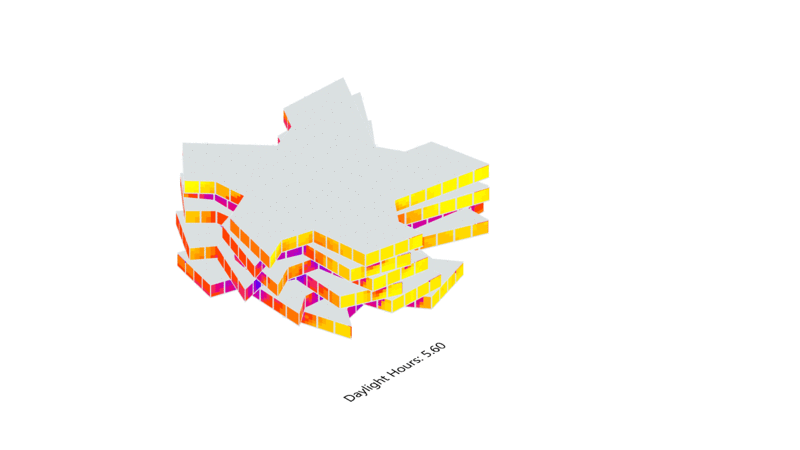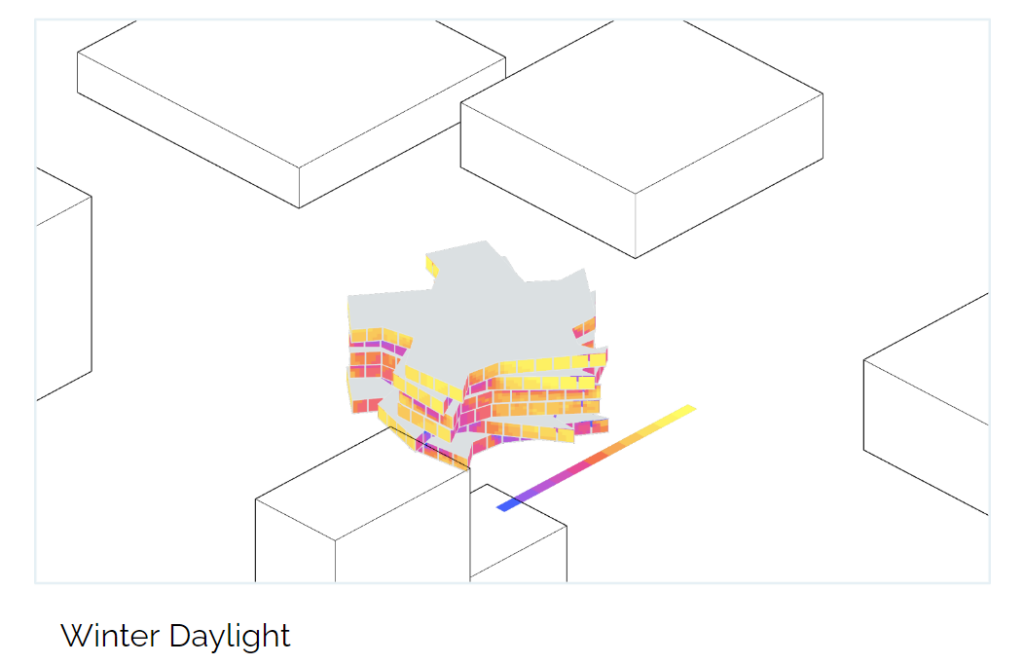Inspired by fractalization and branching of “snowflakes”

Fractal growth refers to the development or expansion of structures or patterns in a way that exhibits self-similarity at various scales.
Fractals are often characterized by intricate and complex shapes that can be created through iterative processes for efficiency and structurability.
Fractal patterns assist us with research into climate change, trajectory of meteoroids, cancer research by studying mutation of cell growth, physics, geography, etc.
Benefits of a Snowflake inspired floor plan for hospital design

It is crucial in a hospital for all rooms to maximize the number of natural light hours in all seasons, for patient’s mental health and well-being. Having plenty of natural light, and views impact the mood and healing process off patients, significantly. Snowflakes, which consists of branches allow for maximum rooms, often leading to a double loaded corridor layout. This can maximize the windows for the program, allowing for natural light, solar heat, views and cross ventilation. This project will focus on maximizing the daylight hours in the winter, and minimizing in the summer, to create a comfortable indoor environment.

SUN ANALYSIS

This exercise aims to maximise the amount of daylight hours in the winter, allowing for minimum 5 hours of daylight during the low sun months. However, for a comfortable indoor environment and reduced solar gain, it is minimizing the sun hours during the summer months when the sun is at its maximum altitude. This will be achieved by optimizing light through various criteria – length of each branch on each floor, rotation of the individual floors and window dimensions
PSEUDOCODE

FORM FINDING | PLAN
Transforming the snowflake fractal into 5 hospital wings with hallway width is achieved by applying the fractal logic of dividing the polygon edges by a factor and rotating the edges. Which, later are offset to achieve the width to host rooms. Extracting end points of each curve allows to form a closed curve geometry of branches.

FORM FINDING | POLYGON SIZE
The polygon size can also impact angle of each branch intersection, allowing the most sufficient daylight hours towards the central core of the building. A genepool was created with a series of number to change the size of the central core, allowing daylight for the staff and visitors.

FORM FINDING | BRANCHING LENGTHS
A genepool was created to change the length of the individual segments depending on sun hours in the winter and summer, to find the optimal solution for maximum hours throughout the year.

FORM FINDING | FLOOR ROTATION
To control individual floor rotation, a genepool was created with 6 sliders, to control 6 floor with a height of 4.5m each. The genepool was controlling 180 degree rotation for each floor.

FLOOR FINDING | WINDOWS
The building edge surfaces are being divided with a factor of 5. The central point of these panels are then being scaled to create windows with a slider factor, ranging from 0-1, which is being plugged into the genome of galapagos

ANALYSIS | WORST
A traditional extruded building, regardless of branching achieves, is not ideal when maximizing the daylight hours, since it has less surface area with windows. Having a staggered building is ideal, however, large cantilevers is also not ideal, as it can create pockets of dark, shaded, windy and cold climate. A combination of rotating and adjusting the length of the branches based on sun path can help designers achieve optimal results

ANALYSIS | BEST
The best scenario for each room in an hospital to receive sunlight would be to have the biggest floor plate on the ground level, and gradually decreasing as it gets towards the top. Larger windows at the bottom levels and more branching at the top can help provide passive shading, and continue to provide optimal lighting. This will also provide opportunities for balconies or greenroofs, but decreases useable floor area.


OPTIMIZATION | CATALOG OF RESULTS
To maximize the daylight hours throughout the year, the minimum results of summer sun and maximum results of winter was multiplied together. The resulting number is then used to connect to the fitness value of Galapagos. Since the ladybug components into galapagos require excessive time, the days were set for 1 day in the summer, and 1 day in the winter. From there, an assumption is being made for the entirety of the winter months. Ideally, the analysis would run with more accuracy

OPTIMIZATION | OPTIMAL RESULTS
The best scenario from each iteration has the highest daylight hours, and it is evident it’s due to the comparably less rotation of each floor and less varying lengths of each branch.


OPTIMIZATION | WORST RESULTS
The worst scenario from each iteration has the fewest daylight hours, and it is evident it’s due to the increasing length and rotation of each branch.


OPTIMIZATION | SEASONAL DAYLIGHT HOURS
Final building during the winter months, optimizing the maximum daylight hours throughout the day on each side of the building

Final building during the summer months, optimizing the minimizing direct daylight hours, without causing overheating to the interior of the building

CONCLUSION
The optimization of sunlight hours through galapagos can help shape design that is meant for better cognitive performance and healing. A set of parameters such as windows, maximizing views and allowing for light, length of each wing, the angle of wings and the push and pull can help also create outdoor spaces.
This tool can also allow for shortest path from one end of the hospital to another in case of emergencies.
Many other interior parameters can also be optimized for the best and efficient use of the environment and area.


